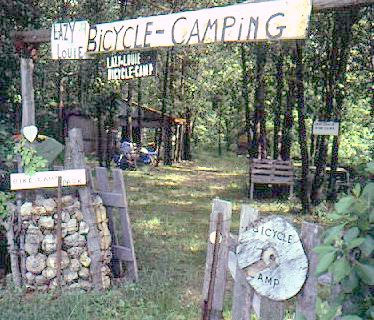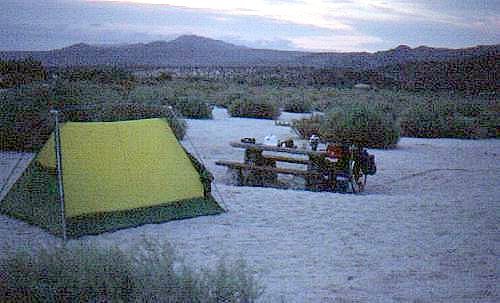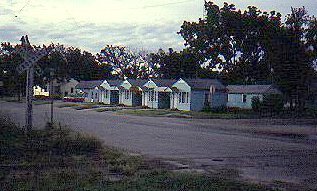 On any long distance bicycle tour, lodging could easily be the biggest expense. When you're at home, you don't think twice about taking a hot shower after your 50-mile ride, plopping down on your soft couch or taking a nice nap in front of the TV.
On any long distance bicycle tour, lodging could easily be the biggest expense. When you're at home, you don't think twice about taking a hot shower after your 50-mile ride, plopping down on your soft couch or taking a nice nap in front of the TV.
Do that on a long bike tour and you'll soon be taking out a second mortgage on that home. Here are 8 suggestions from that harshest teacher of all, personal experience, and things I've read about touring on the cheap.
Let's start with the cheapest:
1. Plan to stay in people's homes: Not only is this usually free, but you still enjoy the creature comforts. Begin by exhausting your network of friends of relatives and relatives of friends when planning your trip.
Next check out the Warm Showers website, which lists 2,300 people willing to host bicyclists around the world, 1,200 in the US alone (more about Warm Showers at Biking Bis). Touring bicyclists also can find homes among the resources at Crazy Guy on a Bike. Also, check out places like the Cookie Lady's Bike House in Afton, Va., on the Adventure Cycling Association Cyclist's Yellow Pages.
2. Allow yourself to get rescued: This is a lot like the above, but it is unplanned. “Rescue” doesn't necessarily mean getting saved from life-threatening situations, it just means someone offers a place to stay and you accept.
I'm still pleasantly surprised at how often this happened on our cross-country bike tour — in Kentucky, Kansas, Colorado, Arizona. A chance meeting, a conversation, then we score warm dry beds, home cooked meals, a chance to get to know someone new and even learn about totally different cultures.
3. City parks: I never would have dreamed about doing this when I started, but Bruce and I camped in city parks — sometimes just crashing on picnic tables under a shelter — repeatedly during the trip. Usually cycling guides suggest checking in with the local police or city hall before doing this, but we never did that. We would just try to find a somewhat out-of-the-way spot and throw up the tent. We were never bothered.
Some of these parks, like the ones in small town on the plains, are only the size of a city block. When we camped at a picnic shelter in the park in Utica, a guy came over (I thought we were in trouble) and told us he'd leave the church across the street open that night so we could wash up in the restroom.
4. Churches, fire stations and other public or quasi-public facilities: There's a guy cycling cross-country right now, Don Boehly, who staying almost exclusively at fire stations. We ran into cyclists on our tour who were welcomed into churches, but that never worked for us, although we did stay at a Methodist preacher's home in Virginia and a shelter adjoined to a church in Kansas.
5. Stealth camping: Allan Stokell is the expert on this. Stealth camping means basically staying out-of-sight on un-marked, un-improved, un-fenced land. He uses a camping hammock and has never been caught. He doesn't recommend doing with another person or cooking at the site. Stokell is interviewed about stealth camping at Cycling Cog.
We did this once on the '84 trip, and to be truthful neither of us slept well that night. That may be because we were nervous sleeping without shelter in the desert; the coyotes barking around us; and the Santa Fe RR locomotive that ran regularly across a trestle right over our heads.
Remember, if you stealth camp and get caught, you didn't read about it here.
 6. Campgrounds: We found the KOAs to be the most expensive, but they offer amenities like hot showers, laundry facilities and a camp store. I think we dropped them from our itinerary after leaving Virginia.
6. Campgrounds: We found the KOAs to be the most expensive, but they offer amenities like hot showers, laundry facilities and a camp store. I think we dropped them from our itinerary after leaving Virginia.
At the time, campgrounds in national parks or forests were the least expensive. The national parks allowed bikers and hikers to share a campsite and didn't require reservations. We also learned that the rangers at the Forest Service campgrounds didn't check the fee box until about 8 in the morning; we made sure we were on the road by then.
The problem with campgrounds, especially the state and private ones, is that they're often miles off your route.
7. Hostels: Not a motel, but not outdoors, the hostels along our bike route offered affordable lodging with a roof over our heads. At the time, American Youth Hostels (now Hostelling International) published a booklet listing hostels costing $3 a person for members, and $6 (I think) for non-members. Several of these were located along our bike route, and we stayed at three or four of them. Currently, the website lists about 120 locations.
In return for low-cost lodging, the lodgers had to do clean-up chores in the morning. The rooms were private and dormitory style. Honestly, I don't know what the rules are now.
 8. Motels, guest houses: Motels are OK once in a while, if you need a pool, TV, hot shower, soft bed. Try for a discount. My friend asked for the “TransAmerica bicyclist” discount at one motel and the guy actually took 10% off the bill.
8. Motels, guest houses: Motels are OK once in a while, if you need a pool, TV, hot shower, soft bed. Try for a discount. My friend asked for the “TransAmerica bicyclist” discount at one motel and the guy actually took 10% off the bill.
If you have any suggestions, please send them in. I'm sure there are a couple of obvious ones I missed.

Recent Comments